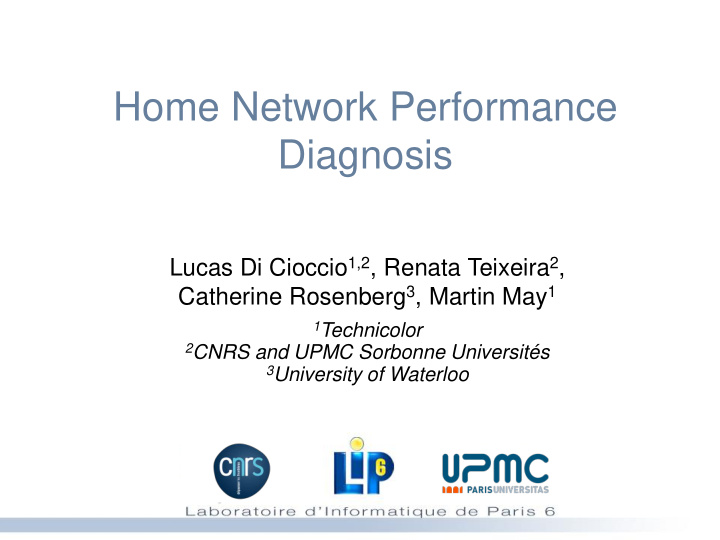



Home Network Performance Diagnosis Lucas Di Cioccio 1,2 , Renata Teixeira 2 , Catherine Rosenberg 3 , Martin May 1 1 Technicolor 2 CNRS and UPMC Sorbonne Universités 3 University of Waterloo
Home networks are becoming complex Internet 1
Our goal Develop techniques to assist users to diagnose performance problems in the home network 2
Roadmap Study contribution of the home net to e2e performance – Controlled experiments HomeNets2010 – Impact on latency and download speed Characterize home networks http://cmon.lip6.fr/hnp – Data collection: HomeNet Profiler Design a troubleshooting tool for home networks – Study tradeoff between diagnosis on the end-hosts vs. gateway 3
Does the home network contribute to e2e performance? Intuitively, home net affects e2e performance – No study quantifies the impact of the home network – In which situations? – Can existing tools attribute performance disruptions to the home network? Our approach: controlled experiments – Test typical French services 4
Experiment setup Competing computer Set-top box (Ethernet or WiFi) (Ethernet) Server at LIP6 ADSL 8 Mbps / 1 Mbps Internet Measurements: Monitor - RTT (delay sensitive) Phone (Ethernet or WiFi) - HTTP DL (bandwidth hungry) (RJ11) 5
Case studies 5 scenarios to test each factor independently – Idle: performance baseline – Phone: triple play IP phone from the ISP – TV: triple play IP TV from the ISP – UL: competing TCP upload – DL: competing TCP download 6
Triple-play services and HTTP DL Cumulative fraction of downloads TV Phone reduces download TV uses 3Mbps rates deterministically only slightly Phone Idle End-to-end HTTP download rate (kbps) 7
Home cross traffic and HTTP DL Cumulative fraction of downloads Idle DL UL Home cross traffic reduces HTTP DL ~3Mbps (50%) when incoming ~4Mbps (65%) when outgoing End-to-end HTTP download rate (kbps) 8
Summary Home can significantly affect e2e performance – Competing upload has highest impact – Competing download also disruptive, but less – TV deterministically cuts DL rates by 3Mbps – Phone has negligible effect on performance End-host tools cannot attribute performance degradations to the home network 9
Roadmap Study contribution of the home net to e2e performance – Controlled experiments – Impact on latency and download speed Characterize home networks – Data collection: HomeNet Profiler Design a troubleshooting tool for home networks – Study tradeoff between diagnosis on the end-hosts vs. gateway 10
How do home networks look like? Goal: Measure a large variety of homes Questions – What are the most common home net configs? – How are homes connected to Internet? – Which devices can we find in home nets? – Which services, protocols, and tools do home devices support? Approach – HomeNet Profiler: data collection at end-hosts 11
Design challenges Easy to use – Portable to most operating systems – One-shot, no installation required Incentives to participate – Report to learn about home network Privacy concerns – Use random identifiers to match repeated reports – Anonymize reported values – Users can skip measurements 12
Collected data User survey Performance – Internet plan – Traceroute to LIP6, – Connectivity of devices DNS server in home network – HTTP DLs to LIP6 Network information Gateway information – Count devices in home – UPnP implementation network Computer config – Neighbor WiFis – Installed/running applications 13
Status Home nets: important factor of e2e performance – But, hard to pinpoint home networks as cause HomeNet Profiler to collect data on home nets – Runs for MacOS, Linux, and Windows Next steps – Distribute HomeNet profiler – Evolve HomeNet Profiler into end-host diagnosis tool – Design a gateway-based diagnosis tool 14
Thank you! To run HomeNet Profiler: http://cmon.lip6.fr/hnp 15
Recommend
More recommend